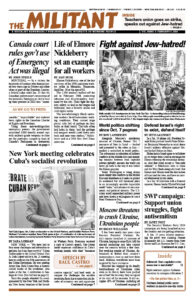Missile attacks launched by Houthi forces in Yemen on shipping in the Red Sea are aimed at weakening Israel. They hope to get Washington to step up pressure on Israel’s rulers to call a cease-fire in Gaza, putting an end to Israel’s efforts to decisively defeat Hamas.
Like Hamas, the Houthis are part of Tehran’s reactionary “axis of resistance,” spreading the poison of Jew-hatred. The Iranian rulers supply both groups with funding, missiles and military collaboration.
Houthi attacks on shipping lanes intensify the challenges Washington faces defending the U.S. rulers’ own capitalist interests in the Middle East and highlight the accelerated crisis of the imperialist world order. Several rounds of U.S. airstrikes on Houthi weapon facilities in Yemen have not deterred the group from its attacks in the Red Sea and Gulf of Aden.
Commanders from the Iranian rulers’ Islamic Revolutionary Guard Corps are based in Yemen, Reuters reports, helping to direct the attacks.
Between 70% to 80% of container traffic in the Red Sea has been rerouted since December, as shipping companies turn to lengthier routes, cutting profits and disrupting supply chains. Since Oct. 7, Houthi forces have also launched drone and missile attacks on Israel, which have so far either missed their targets or been shot down.
Bloodthirsty Houthi leaders glorify Hamas’ Oct. 7 slaughter of Jews in Israel. Houthi Political Bureau member Hezam Al-Asad posted a picture of Hitler Oct. 29, along with him saying, “I could have killed all the Jews in the world, but I left some of them alive so the world would know why I killed them.”
“We want to tell them that the fish are hungry,” Al-Asad said Nov. 15.
Who are the Houthis?
The Houthis are an extended clan based in northwestern Yemen who practice the Zaydi branch of Shiite Islam. Zaydis make up 35% of the country’s population. The majority of Yemenis are Sunni Muslims. And not all Zaydis support the Houthis. It is Tehran’s backing that accounts for their strength. The Iranian rulers are also Shiite Muslims.
Jew-hatred has been integral to the movement that Houthi leaders have built since emerging as a political force in the early 2000s. Hussein al-Houthi, a prominent Zaydi cleric and former member of parliament, rallied supporters to protest against Yemen President Ali Saleh and his ties with the U.S. and Israeli governments. Saleh and Washington were allied against al-Qaeda, which bombed the USS Cole in the Yemeni port of Aden in 2000, killing 17 sailors.
“The Jews are really ruling the world,” al-Houthi claimed in a widely circulated 2001 sermon. Zaydi Muslims have “a great responsibility,” he said, to “be more conscious than the Iranians, more than Hezbollah … to bear enmity toward the Jews.” We “will not be delivered from the evil of the Jews except by their eradication, and by the elimination of their entity [Israel].”
Houthi leaders also blamed Saleh’s corruption for intolerable living conditions in Yemen, the poorest country in the Arab world.
In armed clashes between Houthi forces and government troops, Hussein al-Houthi was killed in 2004. His supporters, now led by his brother, Abdul Malik al-Houthi, launched a series of uprisings. In their northern stronghold of Saada, they gave some 70 Jews who lived there 10 days to get out in 2007. Almost all of Yemen’s 55,000 Jews had already fled the country in the years after 1947, when 82 Jews were massacred in a pogrom in the city of Aden.
Houthis seize territory, target Jews
Following the spread of broader anti-government protests inspired by the Arab Spring revolt in Tunisia and Egypt in 2011, Saleh was forced to resign. New President Abed-Rabbo Mansour Hadi had little popular support and Houthi forces were able to seize territory, capturing Sanaa, the capital, in 2015. They deepened their links with Tehran.
Under Houthi rule, working people face reactionary assaults. Women are oppressed, not allowed to travel without the permission of a male relative. In 2015 Houthis publicly beat two of the few remaining Jews, boys in Sanaa who refused to disavow their religion. Since seizing the capital, their sharia courts have issued some 350 death sentences against political opponents, journalists and others.
A coalition of nine Arab governments, led by the Saudi monarchy, began airstrikes against Houthi positions in 2015, aiming to restore the rule of the unpopular Hadi government. But the rulers of Iran stepped up the provision of arms and funding to the Houthis, which was decisive for them maintaining control of the territory they had seized. A cease-fire was signed with Riyadh in April 2022. In the course of the war close to 400,000 Yemenis were killed and millions faced starvation and disease.
For the rulers in Tehran, getting a base of support in Yemen, on the southern edge of the Arabian Peninsula, provides another outpost in their drive to expand their reach and reactionary political aims. It strengthens their capacity to target the Saudi rulers, their main rival among Arab governments, as well as Israel.
The bourgeois clerical regime in Iran came out of a counterrevolution aimed at pushing back gains won by workers, women, oppressed nationalities and farmers during the popular 1979 Iranian Revolution that toppled the U.S.-backed shah and opened up space for working people to fight in their own interests.
Since then Iran’s capitalist rulers have established Shiite-based armed forces, like Hezbollah in Lebanon, and militias in Syria and Iraq, as well as in Yemen. They have substantially extended their power and influence by force of arms, pursuing the aim of annihilating Israel.

